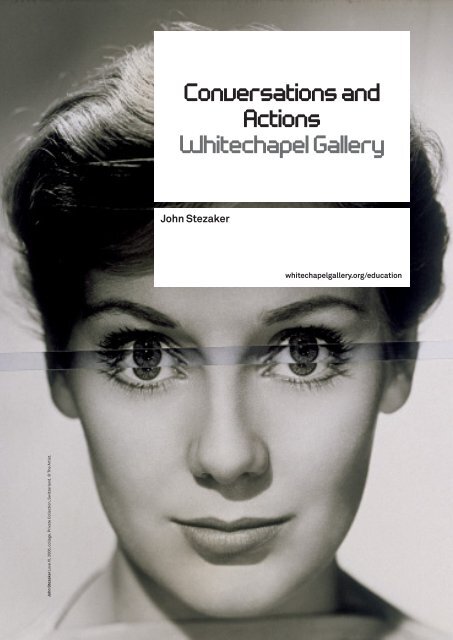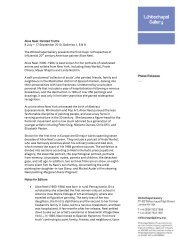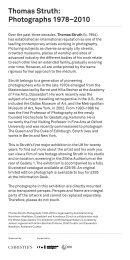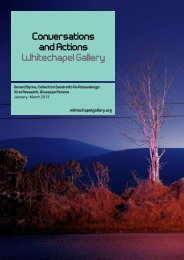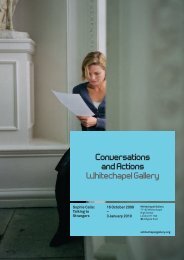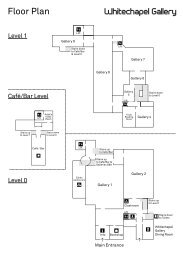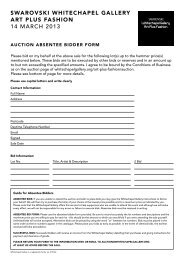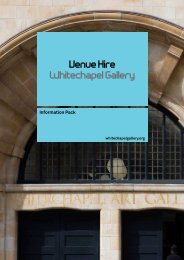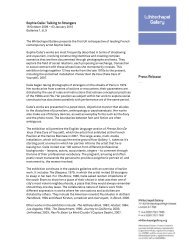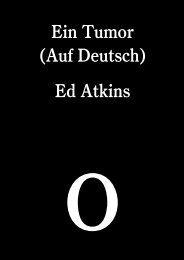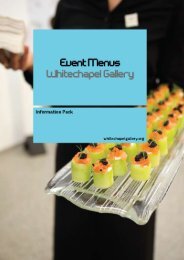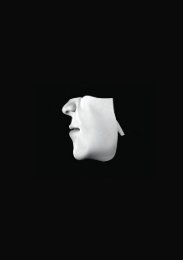John Stezaker - Whitechapel Gallery
John Stezaker - Whitechapel Gallery
John Stezaker - Whitechapel Gallery
Create successful ePaper yourself
Turn your PDF publications into a flip-book with our unique Google optimized e-Paper software.
Conversations and<br />
Actions<br />
<strong>Whitechapel</strong> <strong>Gallery</strong><br />
<strong>John</strong> <strong>Stezaker</strong><br />
whitechapelgallery.org/education<br />
<strong>John</strong> <strong>Stezaker</strong> Love XI, 2006, collage. Private Collection, Switzerland. © The Artist.
<strong>John</strong> <strong>Stezaker</strong> Love VI, 2006, collage. Private Collection, London. © The Artist.<br />
Conversations and Actions<br />
This booklet has been written to help you explore<br />
the <strong>John</strong> <strong>Stezaker</strong> exhibition.<br />
It contains a conversation that outlines key<br />
ideas and concepts around the artworks in the<br />
exhibition and in <strong>John</strong> <strong>Stezaker</strong>’s art practice.<br />
It aims to support your exploration of the<br />
exhibition and give you ideas to share with others<br />
in your group, whatever their age.<br />
Throughout the booklet are actions that you can<br />
do in the <strong>Gallery</strong>. These appear in the boxes with<br />
the wavy lined edge and will help you consider<br />
the artists’ ideas, working processes or more<br />
directly the work and themes of the exhibition.<br />
These actions are easily adaptable to suit a<br />
wide-range of different interests and abilities.<br />
Also, within the booklet are actions that can be<br />
used beyond the <strong>Gallery</strong>, these appear in the<br />
boxes with the diamond patterned edge. They too<br />
can be easily adapted.<br />
Spread throughout are images that you can use<br />
as prompts, or as a reminder of the exhibition.<br />
Have fun!
Mask X, 1982, Collage, 24.5 × 18 cm | 9.7 × 7.1 in<br />
Tabula Rasa xi, 2008, Collage, 18.7 × 23.8 cm | 7.4 × 9.4 in
<strong>John</strong> <strong>Stezaker</strong><br />
Daniel<br />
The title of this exhibition is just the artist’s name, <strong>John</strong> <strong>Stezaker</strong>. It’s a retrospective.<br />
Rebecca<br />
The show is a collection of his works on paper, much of which are bodies of work that he is<br />
still working on. Some of the work has never been seen anywhere else before. He’s really<br />
interested in images.<br />
Daniel<br />
Rebecca<br />
Daniel<br />
But his artworks aren’t simply photographs and prints, they’re objects. I can see the<br />
damage on the side of some postcards, like they may have actually been posted - they had<br />
a life before <strong>Stezaker</strong> found them and used them to make his artwork.<br />
He sources a lot of them from second-hand shops and through ebay, then made minimal<br />
interventions or changes to them, transforming them into something completely new in a<br />
very delicate way.<br />
Cutting an image seems to be a quick and violent act to me.<br />
Rebecca<br />
It’s both a fast and a slow process. <strong>Stezaker</strong> says that although it can take him just thirty<br />
seconds to make the cut, it can take a year or two to make a decision about it – he really<br />
lives with his artwork.<br />
Daniel<br />
I find the mask artworks slightly unnerving because the people in them are hidden by the<br />
postcards, we can see them but they can’t look back at us. It’s like <strong>Stezaker</strong> has<br />
blindfolded them.<br />
Rebecca<br />
But the way the postcards line up with the hairlines, eyes and noses of the people<br />
underneath reveals a new face made up of parts of the top image.<br />
Daniel<br />
The images he has chosen are of places where things originate from, like springs,<br />
waterfalls and caves. There is something behind them or coming out of them.<br />
Rebecca<br />
Now, I’m not just wondering about the hidden faces, but what’s hidden in the caves.<br />
They could be portals or entries into other spaces, bringing new life to the images they<br />
are covering.<br />
Daniel<br />
I find it amazing how well he makes two images fit together without manipulating their<br />
sizes, enlarging or shrinking them. They fit by chance.<br />
Rebecca<br />
The juxtaposition of images in most of his work reminds me of day dreaming. Like being in<br />
an office and thinking about being outside.<br />
Daniel<br />
There’s definitely an inside/outside feel, not just indoors and outdoors but what someone<br />
is doing and what they are thinking.
Pair iv, 2007, Collage, 19.5 × 25.2 cm | 7.7 × 9.9 in<br />
Pair iii, 2007, Collage, 20.5 × 25 cm | 8.1 × 9.8 in
The Process of Re-function<br />
Rebecca<br />
Daniel<br />
The way <strong>John</strong> <strong>Stezaker</strong> combines images changes them from what they were before<br />
into something new – like giving them a new life.<br />
I’ve heard him describe images as lying in wait for him to discover, like homeless<br />
orphans. Once they become part of his collection they are saved and can be seen<br />
for what they are and become visible.<br />
Creative Connections<br />
Bring a selection of random found images into the <strong>Gallery</strong>, these could be:<br />
– Postcards<br />
– Old photographs<br />
– Images from magazines or newspapers<br />
– Illustrations taken from unwanted or second-hand books<br />
In pairs take one image around the <strong>Gallery</strong>. Try and make connections between it and a number of<br />
different artworks throughout <strong>Gallery</strong> 1.<br />
You could make a link between your image and the artwork through:<br />
– Shapes<br />
– Colours<br />
– Subjects<br />
– Settings<br />
– An experience or a memory that both the artwork and found image remind you of<br />
Bring out the possibilities of an image by physically linking it to another image<br />
Use the same or similar found images as the last activity to make collages.<br />
Try using two different types of image:<br />
– Film Stills – Landscapes – Objects<br />
– Portraits – Buildings – A theme from your own work<br />
Combine two images by:<br />
– Lining up a face with a landscape image to make it appear like human features.<br />
– Use an image with depth on top of a close-up image to allow you to look through it.<br />
– Put a close-up image on top of a landscape<br />
– Cut-away a shape from one image that allows you to see through to another one underneath –<br />
this could be a silhouette.<br />
– Mix colour and black and white.<br />
Try different combinations of images before you decide on your final piece.<br />
Keep it simple - don’t be tempted to use too many images, one or two should be enough.
A selection from The 3rd Person Archive, 1.4; 1.8, 1.11; 1.13;, 2.1, 1976–present, Image fragments
Common Denominators<br />
Daniel<br />
Rebecca<br />
Daniel<br />
The <strong>Gallery</strong> space is divided into sections, but it’s not chronological.<br />
The works are grouped by the way <strong>Stezaker</strong> has engaged with and used the images.<br />
Sometimes his series of works span long periods which overlap.<br />
There’s a sense of déjà vu, not just because some of his artworks remind me of things I<br />
think I’ve seen but can’t quite pinpoint, but they also remind me of each other too. The<br />
same types of images appear in different bodies of work.<br />
Creative Collections<br />
Draw a simple aerial plan of part of <strong>Gallery</strong> 1 on an A4 sheet of either one of the long walls on each<br />
side, or one of the ‘T’ shaped wall sections in the middle. Indicate where the divisions and partition<br />
walls are. Each of these areas has three ‘groupings’ of work.<br />
On your plan mark each area with a title that describes the way the artworks in that grouping or<br />
section are created.<br />
– Removing<br />
– Combining<br />
– Altering<br />
– Cropping<br />
– Selecting<br />
– Mirroring<br />
– Similar<br />
– Opposite<br />
– Adding<br />
Now look at the actual subjects in the images.<br />
Use coloured lines to mark connections between the artworks in each section, joining any sections<br />
where artworks have used similar source images, for example:<br />
– Postcards<br />
– Portraits<br />
– Landscapes<br />
– Black and white<br />
– Colour<br />
– Film Stills<br />
Remember to use a colour or other key for these lines.<br />
3rd Person Archive (on the far wall from the entrance to <strong>Gallery</strong> 1)<br />
Daniel<br />
Rebecca<br />
The 3rd Person Archive is a collection of over 300 images taken from travel literature.<br />
By selecting an image, then cropping just part of it, <strong>Stezaker</strong> has made it into an<br />
artwork.<br />
He actually lost his archive, but remembering where he got the images from and the<br />
exact criteria he had used to select them, he recreated the archive. Later he found the<br />
original and discovered that both the new collection and the old looked almost identical.
Use an online image search to collect images inspired by a theme from <strong>Stezaker</strong> source images by<br />
using a search word such as film stills, portraits or landscapes or your own theme.<br />
Develop a list of criteria for selecting which works go in your collection, for example they must:<br />
– Contain a certain colour<br />
– Be portraits of unknown people<br />
– Must paintings not photographs<br />
– Only be landscapes with seas<br />
Print out these images. Crop them following a rule of your own.<br />
Organise them in a certain order.<br />
Name your archive and talk through your process with a friend or write about it.<br />
Ideas to spark your imagination<br />
Develop your own activities around the following starting points:<br />
Look at the Marriage(Film Portrait Collage) series of works for inspiration (next page).<br />
– Use mirrors/mirror card along lines of symmetry on your own face. Work in pairs to draw or<br />
photograph each other.<br />
– Angle small compact mirrors in front of your face to reflect something else in the room. Work in<br />
pairs to draw or photograph each other.<br />
– Combine publicity photographs of modern celebrities – find them on www.imdb.com or in<br />
celebrity magazines.<br />
– Use a computer image editing software to mirror, flip and rotate sections of a scanned found<br />
image or download image.<br />
– Experiment using photocopies of your own artwork to cut and edit.<br />
– Fold or cut portraits in half vertically. In groups experiment matching different combinations halffaces<br />
together. Discuss what works and how you make decisions on how the two halves match up.<br />
Other works in the <strong>Gallery</strong> in which <strong>Stezaker</strong> uses similar techniques include the series Lost Tracks<br />
and The Fall.<br />
Look at the Love series (see cover, and introduction page) for inspiration<br />
– Fold photocopies of portrait photos in a concertina style to conceal sections<br />
– Print the same image twice. Make one cut in one image from one edge to the other. Lay it on top of<br />
the other uncut copy.<br />
– Overlap two or three of the same image.<br />
Try paying attention to only one facial feature such as the eyes when matching up.<br />
Look at the Enter… Exit the Third Person series (Last page) for inspiration<br />
– Try to create the feeling of movement by collaging fragments of enlarged and shrunk versions of<br />
an image with the original.<br />
– Collage a series of screen-shots from a film to tell part of the story.<br />
– Use photos you have taken with a camera set to continuous frame rate, (taking multiple images in<br />
a row whilst shutter button held down), to collage into one image.<br />
– Remove elements from just one image.<br />
– Shift around elements from just one image.
Marriage (Film Portrait Collage) lvi, 2007, Collage, 25.8 × 23.8 cm | 10.2 × 9.4 in
Enter… Exit the Third Person, 1978, Collage, Image: 28.6 × 25.1 cm | 11.3 × 9.9 in<br />
This Conversations and Actions resource was written by artist Daniel Wallis.<br />
To book your free group visit and use our Education Space (available Tuesday,<br />
Wednesday and Thursday during term time) please call Education on 020 7522 7888<br />
or email: education@whitechapelgallery.org<br />
If you have enjoyed this Conversations and Actions or have any other feedback<br />
please do contact us.<br />
For more Conversations and Actions visit<br />
<strong>Whitechapel</strong>gallery.org/education/schools/teacher<br />
Exhibition supported by:


